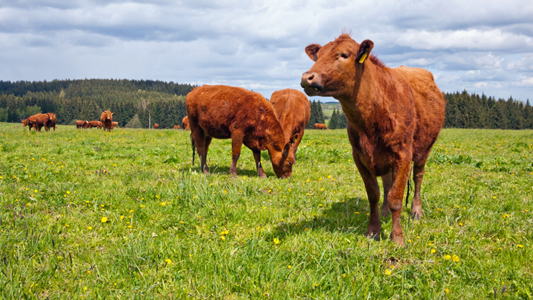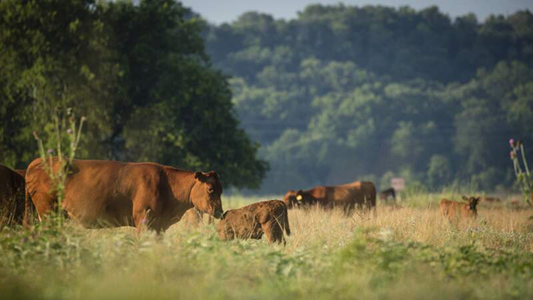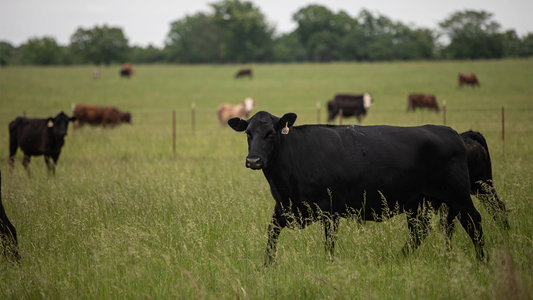
How It Works
Altosid® IGR is an insect growth regulator (IGR) that passes through the animal and into the manure, where horn flies lay their eggs. It breaks the horn fly life cycle, preventing pupae from developing into biting adult flies. There's no need to round up or handle cattle because the animals spread the horn fly control as they graze, placing it in the exact location where horn flies lay their eggs.
- Altosid® IGR is ingested with the cattle's mineral or feed. As they graze, cattle disperse the IGR via their manure.
- Adult horn flies live for 2-4 weeks, taking 20-40 blood meals per day.
- Female flies leave the animal for a few seconds to lay eggs in fresh manure less than 5 minutes old.
- In 1-2 days, eggs hatch into larvae.
- In 3-5 days, the horn fly larvae molt into pupae.
- Pupae molt into adults in 6-8 days. Altosid® IGR breaks the horn fly life cycle here before that happens, preventing adults from emerging.
Horn flies bite cattle's backs and midlines, spreading down their sides. This location is tough for cattle to reach, leading to the irritation that causes cattle to go off feed. To stop this problem, it is easier to attack flies where they lay their eggs and prevent the emergence of future populations.
To expand your knowledge on Altosid® IGR, we will be answering your most frequently asked questions.
Q: What is the economic effect of horn flies on cattle production?
A: Profit losses from a horn fly infestation begin when the population exceeds the economic threshold of 200 flies per animal. When left untreated, horn fly infestations can reach up to 4,000 flies per animal, staying on the cattle day and night. Horn flies are the number one economic ectoparasite in North American cattle production, causing an estimated $1 billion loss annually. Compare this to the estimated loss of bovine respiratory disease at $600 million or pinkeye at $100 million. Establishing a horn fly control plan and incorporating a feed-through product, like Altosid® IGR, will reduce costly blood losses and promote healthy profits.
Q: How can I tell if I have a horn fly problem?
A: Horn flies are an ectoparasite of cattle and tend to stay on the backs and sides of animals throughout the day. Despite their name, horn flies do not congregate on the horn and head area. Horn flies are about half the size of the common house fly and lay eggs exclusively in fresh manure. They feed on the cow's blood, which can cause weight loss, changes in grazing patterns and decreased milk production. These flies are also linked to reduced calf weaning weight and spread harmful diseases to the herd, including pinkeye and mastitis.
Q: How do horn flies affect cattle?
A: Horn flies cause cattle stress, and under stress, cattle will not feed as freely and may move to areas in or near water to escape fly pressure. Horn flies feed on the blood vessels in the skin of the teat, spreading mastitis bacteria while they feed. If left untreated, the bacteria can migrate from the scab left from the fly bites, moving into the quarter and destroying milk-producing tissues. Typical weight loss is estimated at 15 to 50 pounds per yearling. Also, a 10- to 15-pound weaning weight advantage results when good horn fly control is used.
Q: What's the best way to control horn flies?
A:The easiest way to control horn flies is to use an insect growth regulator (IGR), which allows you to add horn fly control right in your feed or minerals, letting cattle do the work. This is much less labor-intensive than other options, such as dust bags and back rubbers. Altosid® IGR, partnered with an effective IPM program, will protect your herd and your profits from horn fly damage. Altosid® IGR is not only the recommended horn fly control solution, it is the original horn fly control solution. It was the first feed-through larvicide to receive EPA approval in 1975, and because of its target-specific mode of action, it remains effective to this day.
Q: How do I know if my horn fly problem is worth treating?
A:University research indicates the economic threshold for horn flies is 200 per animal and for dairy cattle, it may be as low as 50 flies per animal. Horn fly populations expand quickly, causing infestations. In untreated herds, fly infestations can increase rapidly to upwards of 4,000 flies per animal. While you will never eliminate all flies on cattle, maintaining a fly control program will help limit populations to less than 200 flies per animal, the economic threshold established for horn flies on beef cattle.
Q: How do I calculate the cost of horn fly control?
A:The cost per animal will vary and can be measured on a return-on-investment (ROI) basis. For ear tags, you should also consider the cost of labor to determine the actual cost per animal.
An effective fly control program keeps horn fly levels at less than 200 flies per animal. In addition, Altosid® IGR controls horn flies resistant to the organophosphates and pyrethroids commonly used in conventional cattle fly control products. In more than 40 years of use, there have been no known cases of insect resistance to Altosid® IGR.


